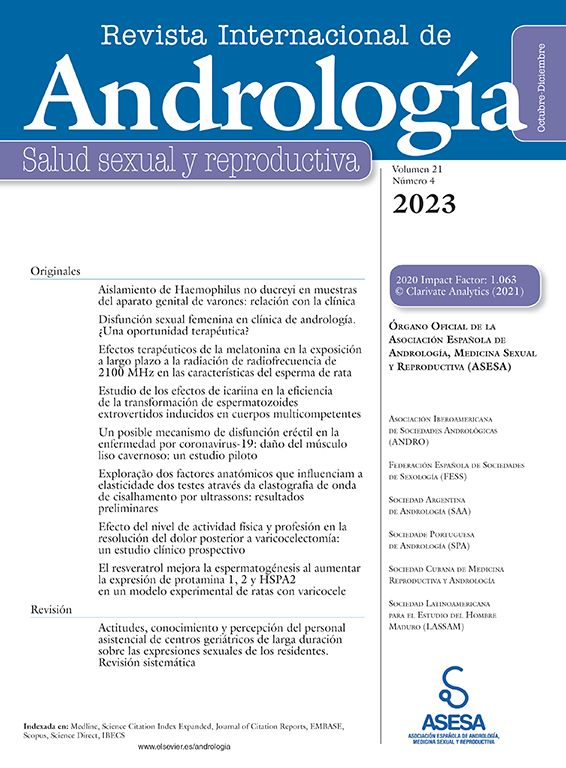Urethral coitus is a very rare condition that causes urinary incontinence and urethral dilatation. Urethral coitus with the presence of intact and normal vagina may be as a result of multiple vaginal births and a severely dilated vagina. There are different ways of coitus. Oral sex, vaginal sex, anal sex and urethral sex are different ways of sexual intercourse. Oral, vaginal and anal ways are frequently used ways but urethral way is a strange and rare way to have sex. Transobturatory tape is a frequently used technique for the surgical treatment of stress urinary incontinence. Transobturatory tape operation would not be useful alone for the patients with severe urethral dilatation and urinary incontinence.
El coito uretral es una situación poco frecuente que ocasiona incontinencia urinaria y dilatación uretral. El coito uretral con la presencia de una vagina intacta y normal puede ser consecuencia de varios partos vaginales y de una vagina gravemente dilatada. Existen distintos tipos de coito: el sexo oral, el sexo vaginal y el sexo uretral son maneras diferentes de relaciones sexuales. Las vías oral, vaginal y anal son frecuentes, pero la vía uretral es extraña e inusual para el coito. La cinta transobturadora es una técnica habitual para el tratamiento quirúrgico de la incontinencia urinaria de esfuerzo. La intervención con cinta transobturadora no sería por sí misma un método válido para pacientes con dilatación uretral grave e incontinencia urinaria.
Urethral coitus is a very rare condition that causes urinary incontinence and urethral dilatation.1–4 This condition is usually seen in women with vaginal or hymenal anomalies.1,3,5 Also this may be seen with intact vagina.1 There is a close anatomical relationship with urethra and external genital organs.6 This close relationship may lead urethral traumas during coitus.6,7 Urethral coitus with the presence of intact and normal vagina may be as a result of multiple vaginal births and a severely dilated vagina. There are several causes and different types of urinary incontinence in women. Urethral coitus is a very rare cause of urinary incontinence. In this case we aimed to present a 72 year-old, sexually active, multiparous female patient with intact vagina and severe urinary incontinence due to regular urethral coitus.
Case report72 year-old female patient admitted to our clinic with a 5-year history of severe urinary incontinence. The complaint of urinary incontinence was increasing after sexual activity and the patient had also a history of total abdominal hysterectomy operation and three normal vaginal births. When the sexual relationship was queried, the patient and her husband had sex for one or two times a week regularly and the couple clearly explained that they had sex through urethral way. According to the physical examination, urethra was seen as severely dilated and there was a rectal prolapse (Fig. 1). There was a urine leakage without intervention. Also there was urine leakage with bladder stress test. The urine test and biochemical parameters were normal. According to the urodynamic tests, the diagnose was stress urinary incontinence. Transobturatory tape and urethral repair operation was planned for the patient. Before the operation we performed urethroscopy and cystoscopy. There were no additional pathologies. During the operation, urethral catheter was inserted and firstly transobturatory tape was performed. The mesh tension was adjusted during surgery. After that, an inverted U incision extending from 5 o’clock to 7 o’clock was made on anterior urethral wall. The anterior part of the urethral wall between 5 and 7 o’clock was excised and three 2/0 vicryl plicating sutures were inserted around the urethral catheter (Fig. 2). The urethral catheter was removed on postoperative third day and the patient was discharged. On postoperative first month, the patient had no complaints about urinary incontinence, there was no urine leakage with stress test, uroflowmetry result was normal and there was no post-voiding residual volume. The patient has been followed up now at outpatient clinic for 6 months. For the rectal prolapse of the patient, an additional operation was planned.
DiscussionThere are different ways of coitus. Oral sex, vaginal sex, anal sex and urethral sex are different ways of sexual intercourse.6 Oral, vaginal and anal ways are frequently used ways but urethral way is a strange and rare way to have sex. Urethral coitus is a rarely seen condition especially in women with normal vagina and introitus.8 The patient we have reported is the sixth reported case of urethral coitus with normal genitalia and it is the second case in a multiparous woman according to the literature.8 Urethral coitus usually causes severe urethral dilatation and urinary incontinence but in some cases urinary incontinence may not be seen.1 If severely dilated urethra is seen during the physical examination, physician must think about urethral sex and ask additional questions about sexual intercourse.2 There are several types urinary incontinence and most common types of urinary incontinence in women are stress and urge types. Medical and surgical treatment modalities would be used for the treatment of stress urinary incontinence. Transobturatory tape is a frequently used technique for the surgical treatment of stress urinary incontinence. Transobturatory tape operation would not be useful alone for the patients with severe urethral dilatation and urinary incontinence. For these type of patients, especially who had a history of urethral coitus, urethral repair would be successful like the patient we have reported.
Ethical disclosureProtection of people and animalsThe authors declare that the procedures followed were in accordance with the regulations of the relevant clinical research ethics committee and with those of the Code of Ethics of the World Medical Association (Declaration of Helsinki).
Confidentiality of dataThe authors declare that they have followed the protocols of their work center on the publication of patient data.
Right to privacy and informed consentThe authors have obtained the written informed consent of the patients or subjects mentioned in the article. The corresponding author is in possession of this document.
Conflict of interestThe authors declare no conflict of interest.







